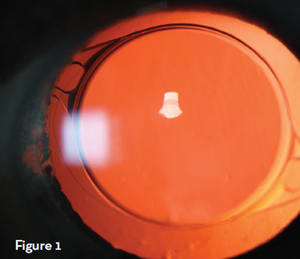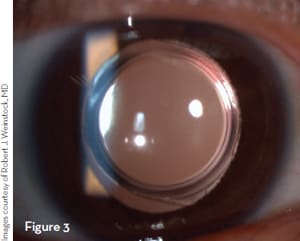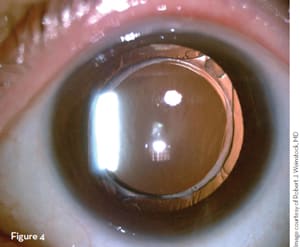New Technologies
Help Eliminate Surgical Variables
The enVista® IOL and the Victus® femtosecond laser are among the innovations that enable consistent vision outcomes.
BY ROBERT J. WEINSTOCK, MD
In the realm of refractive cataract surgery, consistency is king. The more variables we can eliminate to standardize each step of the procedure, the better able we are to refine our results and deliver the spectacle-free vision patients desire. In my practice, I've been using several new technologies that help me ensure accuracy and consistency.
How the Latest Technologies Can Help
Our practice was an early adopter of femto technology, because we believed the femtosecond laser could be used to automate the cataract surgery maneuvers that are most vulnerable to human error, thereby taking our results to the next level. In my practice, we use two different platforms. They've both been outstanding, and I've found the Victus Femtosecond Laser (Bausch + Lomb) to be particularly effective for creating the ideal and complete anterior capsulotomy. Compared to executing these steps by hand, I'm much more likely to achieve a properly sized and centered rhexis that will serve to keep the IOL in the optimum position. I'm also much less likely to have an incomplete rhexis that could compromise the posterior capsule during phacoemulsification.
To achieve the intended postoperative refraction, selecting a high-quality IOL is just as important as using the femtosecond laser and other technologies.
The Victus platform also has FDA clearance for the creation of arcuate incisions, which helps me improve correction of preexisting corneal astigmatism for refractive cataract surgery patients. This is an important goal because even small amounts of residual astigmatism can compromise postoperative uncorrected visual acuity. While manual astigmatism-correcting
incisions, such as limbal relaxing incisions (LRIs) can be effective, the laser can place the wounds in the specified optical zone and axis, and can achieve precise depth across the entire incision more accurately.
I use the femtosecond laser as part of the refractive cataract surgery package I offer to eliminate or reduce patient dependence on eyeglasses or contact lenses. Approximately 50% of the patients in our practice choose an advanced procedure that involves LRIs and/or a toric or presbyopia-correcting IOL. These procedures include additional preoperative steps, such as analysis of corneal astigmatism, wavefront measurements and double and triple-checking of biometry with more than one device. Intraoperatively, I use the femtosecond laser to execute the capsulorhexis and to correct corneal astigmatism where appropriate. I also use the ORA System (wavefront aberrometry by WaveTec Vision) in the OR to take aphakic and pseudophakic measurements for confirming IOL power selection and/or determining the magnitude and axis of astigmatism. In addition, I use the TrueVision 3D surgical system, a surgical visualization system from TrueVision 3D Surgical, Inc. The system incorporates cyclorotation compensation, image registration and real-time eye tracking to help guide toric IOL placement and astigmatism correction.
Once inside the eye, the enVista unfolds smoothly and centers very well, almost automatically.
Individualized IOL Choice
To achieve the intended postoperative refraction, selecting a high-quality IOL is just as important as using the femtosecond laser and other technologies. While the recommendation for many of my patients is a toric or presbyopia-correcting IOL, in some cases, a monofocal lens is the best choice. Some patients, for example, want to have only their distance vision optimized, while others prefer to be nearsighted after surgery. Still others are looking to match the vision they had with a monovision contact lens approach preoperatively. In these types of situations, when I am aiming for precisely targeted vision with a monofocal non-toric implant, the hydrophobic acrylic enVista IOL (Bausch + Lomb) is a good option. It takes the concept of aspheric optics a step further than other designs by not adding or subtracting any spherical aberration (SA) to the visual system. While other aspheric IOLs aim to neutralize the cornea's natural positive SA by introducing negative SA, the enVista does not. After reviewing all of the relevant literature, I believe an aspheric lens that leaves the eye with its natural positive SA provides not only the crispest vision possible but also maintains or enhances depth of field, which improves overall visual function.



Figures 1-3. Three nicely centered enVista IOLs on post-op day 1.
The enVista IOL has another unique feature that contributes to its ability to deliver highquality vision. It is manufactured and packaged in a manner that inhibits the formation of glistenings. Glistenings in other IOLs, especially other hydrophobic acrylic IOLs, have been widely documented. These fluid-filled micro-cavities that form in the IOL material may develop soon after implantation or months or years after. They are another variable that most surgeons would prefer to avoid. Even in cases where glistenings don't seem to be an issue for a patient, they are visible at the slit lamp and can obstruct the view to the retina. Sometimes they seem to be the only plausible explanation for a patient's vision to end up worse after surgery.
The enVista IOL is a solid choice for traditional cataract surgery procedures as well. I'm very comfortable with its proven platform and design. Because it has the added potential advantage of no glistenings, I tend to choose it over other hydrophobic acrylic lenses whenever the benefits of a one-piece acrylic IOL with a square edge and traditional C-loop haptics would minimize potential problems for a patient. This applies most often to patients who have co-existing conditions and who are likely to require care from a vitreoretinal specialist in the future. A clear optic will not interfere with the posterior segment surgeon's view into the eye. Furthermore, hydrophobic acrylic is one of the most frequently used materials in the history of implants. It has a strong track history of being well tolerated. Surgeons have also come to expect that single-piece IOLs with C-loop haptics will remain centered and are unlikely to move anteriorly or posteriorly if a patient undergoes a subsequent surgery with a glaucoma or retina specialist. We've also come to expect that a square-edge design will minimize the risk of posterior capsular opacification (PCO), which makes it more likely that we can avoid YAG laser procedures in eyes that are already otherwise compromised.
Results from enVista Cases With & Without Femtosecond Laser
I've been very pleased with the outcomes I achieve with the enVista IOL. In my initial series of cases, 92% of patients were within 0.5D of plano and the average deviation from intended target was 0.1D.
Not one of my enVista patients has had a vision complaint or any other problem associated with the lens, and the rate of PCO has been extremely low thus far. In our ORs, scrub techs typically load the IOLs into the inserters. They say it's easy to handle and they've had no challenges loading it. We haven't had any instances of ripped lenses or torn-off haptics, which can occur when a staff switches to working with a new IOL or injector. The enVista inserter, which is disposable and designed for one-hand use, works well, too. It was recently improved to allow implantation through a 2.2- to 2.4-mm incision. The bevel angle was increased to make wound entry easier, and a rib was added in the cartridge to minimize lens rotation.
Once inside the eye, the enVista unfolds smoothly and centers very well, almost automatically (Figures 1-4). I prefer to remove all of the viscoelastic from the capsular bag at the end of each case so the lens sits more posteriorly and in the predicted effective lens position. Also, if I remove the viscoelastic completely every time, it is one more variable taken out of the equation. Some surgeons find it helpful to go under the lens or to rock the optic back and forth when removing the visco.

Figure 4. A still-centered, clear enVista IOL 12 months after implantation.
Versatility Plus Consistency
Built on a proven platform with the added advantages of zero-spherical-aberration optics and an absence of glistenings, the enVista IOL is a versatile lens easily incorporated into any surgical practice. Along with other cutting-edge technologies, it contributes in a meaningful way to the achievement of precise, consistent, predictable and patient-pleasing cataract surgery outcomes. For added peace of mind, we can expect the favorable results to endure for the long term.●
|
Dr. Weinstock is the director of Cataract and Refractive Services at the Eye Institute of West Florida and the Weinstock Laser Eye Center and the surgical director of the Largo Ambulatory Surgery Center. He's an associate clinical professor of ophthalmology at the University of South Florida in Tampa. |









